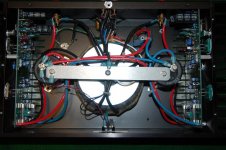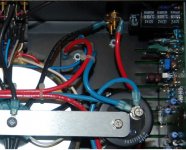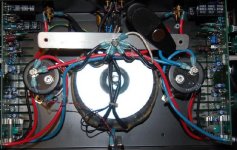I got a vintage Forte Model 5 power amp used. It is a nice sounding amp, but is plagued with a constant, low level HUMMM which is just audible from my listening chair when the room is very quiet. I understand hum modulates/distorts the music which is undesirable. I've checked all cable/cord grounds.
My speakers are an MTM design with 90dB sensitivity (the other owner used Magnapans and didn't notice the hum).
The amp uses a toroidal power transformer and input signal wires are shielded & routed carefully to the rear, away from the power supply components (see pic.)
The hum occurs even when the inputs are shorted/disconnected and when the power amp is the ONLY component used (i.e. everything else except speakers was unplugged) it appears to be within the power amp itself. Unfortunately there is no balanced option in my system, as all components use single-ended RCA.
Any ideas/suggestions to combat this hum?
My speakers are an MTM design with 90dB sensitivity (the other owner used Magnapans and didn't notice the hum).
The amp uses a toroidal power transformer and input signal wires are shielded & routed carefully to the rear, away from the power supply components (see pic.)
The hum occurs even when the inputs are shorted/disconnected and when the power amp is the ONLY component used (i.e. everything else except speakers was unplugged) it appears to be within the power amp itself. Unfortunately there is no balanced option in my system, as all components use single-ended RCA.
Any ideas/suggestions to combat this hum?
Attachments
http://www.sound.westhost.com/psu-wiring.htmlIn addition, capacitors (typically 100nF) are often used across the bridge rectifier, effectively in parallel with each diode. These may help reduce noise
I dont think your transformer is the problem.Have a read of this article.It may help.
Dave
I think you connected ground via this metal tab wrong way.
You created a closed loop of chassis/transformer center screw/ ground tab so that it forms an additional secondary winding and adds hum to ground.
My advice is connect reservoir capacitors to each other different way, not by metal tab connected to transformer screw, use just a piece of wire instead.
You created a closed loop of chassis/transformer center screw/ ground tab so that it forms an additional secondary winding and adds hum to ground.
My advice is connect reservoir capacitors to each other different way, not by metal tab connected to transformer screw, use just a piece of wire instead.
Were they replace for the hum problem.Does the transformer get warm?the filter capacitors were replaced recently and they tested good.
Transformer shorted turn causes transformer to heatup and also induces noise-good eye darkfenriz--additional secondary winding and adds hum to ground.
Dave
Thanks for your kind response.
The Star-Grounding bussbar is NOT connected to Transformer bolt; it "floats" about 3/4" above it (supported by capacitor screws), as designed by Forte. This plate is connected to chassis at one point only. Other grounds come to this one point.
No changes from the original factory assembly except for capacitor and rectifier replacement, and substitution of a non-magnetic base plate.
Please explain to me your ideas on what's causing the hum.
The Star-Grounding bussbar is NOT connected to Transformer bolt; it "floats" about 3/4" above it (supported by capacitor screws), as designed by Forte. This plate is connected to chassis at one point only. Other grounds come to this one point.
No changes from the original factory assembly except for capacitor and rectifier replacement, and substitution of a non-magnetic base plate.
Please explain to me your ideas on what's causing the hum.
Attachments
I did a Google for "Transformer Hum" and found this link:
http://www.soundstage.com/maxdb/maxdb071998.htm
The article states:
"...toroid transformer is very intolerant of DC offset being present at the input (primary winding). In fact, if there is any DC at all in the AC power supplied to a typical AC Power toroid transformer, the laminated metal core of the transformer "saturates" and the transformer no longer operates as designed. The result is often high levels of audible noise from the transformer as well as very high levels of noise getting into the power supply of the component..."
How does one safely test the household AC outlet for DC offset
(I have a multimeter)?
Any ideas on how to reduce the hum (short of replacing the transformer)?
http://www.soundstage.com/maxdb/maxdb071998.htm
The article states:
"...toroid transformer is very intolerant of DC offset being present at the input (primary winding). In fact, if there is any DC at all in the AC power supplied to a typical AC Power toroid transformer, the laminated metal core of the transformer "saturates" and the transformer no longer operates as designed. The result is often high levels of audible noise from the transformer as well as very high levels of noise getting into the power supply of the component..."
How does one safely test the household AC outlet for DC offset
(I have a multimeter)?
Any ideas on how to reduce the hum (short of replacing the transformer)?
One could possibly measure it with a O'scope..How DC would get induced into the AC power baffles me unless some other device on the same AC circuit is the culprit.A new transformer is and expensive gamble.How does one safely test the household AC outlet for DC offset
Dont try to measure DC on the AC with your multimeter .At the least you will blow a fuse in the meter(expensive little fuse).
Hi,
It is not DC being injected into the mains as such.
It is asymetrical draw from the mains that causes the waveform to distort asymetrically.
The millions of switch mode power supplies out there are partly to blame.
As the waveform becomes asymetrical it sends unequal currents through the toroid on alternate half cycles. These unequal currents cause the DC effect and in turn the saturation.
Block the DC by inserting big low voltage caps in the primary feed to the transformer. But make it safe. Read up the various threads here.
This is usually a mechanical hum not electronic from the following stages. I think you have another hum problem.
Remove your star ground from the zero volt plate (0v). Create an audio ground and bring all the grounds and returns to it.
It is not DC being injected into the mains as such.
It is asymetrical draw from the mains that causes the waveform to distort asymetrically.
The millions of switch mode power supplies out there are partly to blame.
As the waveform becomes asymetrical it sends unequal currents through the toroid on alternate half cycles. These unequal currents cause the DC effect and in turn the saturation.
Block the DC by inserting big low voltage caps in the primary feed to the transformer. But make it safe. Read up the various threads here.
This is usually a mechanical hum not electronic from the following stages. I think you have another hum problem.
Remove your star ground from the zero volt plate (0v). Create an audio ground and bring all the grounds and returns to it.
- Status
- This old topic is closed. If you want to reopen this topic, contact a moderator using the "Report Post" button.
- Home
- Amplifiers
- Solid State
- Need help combating power amp hum


